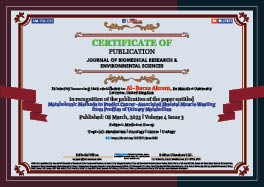Al-Baraa Akram*
Volume4-Issue3
Dates: Received: 2023-02-11 | Accepted: 2023-03-06 | Published: 2023-03-08
Pages: 331-337
Abstract
It is known that cachexia is a cancer-associated muscle wasting and reduction in the function status due to treatment especially chemotherapy and in life expectancy, to assess cachexia muscle loss there are many methods as Computed Tomography (CT) scan which has many disadvantages as high cost, invasive, time consuming and cannot detect early stages of muscle wasting [1].
This novel approach uses single-time point urinary metabolite profiles for determining whether the patient is subjected to muscle wasting by analysis of 93 random urine samples from patients with cancer using 2 successive CT images by assessing of lumbar skeletal muscle area by cubic centimeter to estimate the rate of muscle change per time for every patient.
The average muscle change over time was -4.71% in 100 days in the muscle-losing group and 3.91% in 100 days in the control group. Bivariate statistics identified metabolites to muscle wasting including constituents and metabolites of muscle as creatine and creatinine, amino acids as serine, threonine, glutamic acid, isoleucine and valine.
These results suggest that urine analysis of a single random urine sample is cheap, fast, and non-invasive tool to screen muscle loss and it is useful to clarify prediction of related metabolic conditions possible with methodology presented.
The metabolomics methods used in this article are Univariate analysis T-test, correlation analysis, principal component analysis and heatmap clustering.
FullText HTML
FullText PDF
DOI: 10.37871/jbres1680
Certificate of Publication

Copyright
© 2023 Al-Baraa A. Distributed under Creative Commons CC-BY 4.0
How to cite this article
Al-Baraa A. Metabolomic Methods to Predict Cancer-Associated Skeletal Muscle Wasting from Profi les of Urinary Metabolites. 2023 Mar 08; 4(3): 331-337. doi: 10.37871/jbres1680, Article ID: JBRES1680, Available at: https://www.jelsciences. com/articles/jbres1680.pdf
Subject area(s)
References
- Akçay MN, Akçay G, Solak S, Balik AA, Aylu B. The effect of growth hormone on 24-h urinary creatinine levels in burned patients. Burns. 2001 Feb;27(1):42-5. doi: 10.1016/s0305-4179(00)00056-5. PMID: 11164664.
- Antoun S, Baracos VE, Birdsell L, Escudier B, Sawyer MB. Low body mass index and sarcopenia associated with dose-limiting toxicity of sorafenib in patients with renal cell carcinoma. Ann Oncol. 2010 Aug;21(8):1594-1598. doi: 10.1093/annonc/mdp605. Epub 2010 Jan 20. PMID: 20089558.
- Asp ML, Tian M, Wendel AA, Belury MA. Evidence for the contribution of insulin resistance to the development of cachexia in tumor-bearing mice. Int J Cancer. 2010 Feb 1;126(3):756-63. doi: 10.1002/ijc.24784. PMID: 19634137.
- Bertini I, Calabrò A, De Carli V, Luchinat C, Nepi S, Porfirio B, Renzi D, Saccenti E, Tenori L. The metabonomic signature of celiac disease. J Proteome Res. 2009 Jan;8(1):170-7. doi: 10.1021/pr800548z. PMID: 19072164.
- Bidlingmeyer BA, Cohen SA, Tarvin TL. Rapid analysis of amino acids using pre-column derivatization. J Chromatogr. 1984 Dec 7;336(1):93-104. doi: 10.1016/s0378-4347(00)85133-6. PMID: 6396315.
- Bollard ME, Stanley EG, Lindon JC, Nicholson JK, Holmes E. NMR-based metabonomic approaches for evaluating physiological influences on biofluid composition. NMR Biomed. 2005 May;18(3):143-62. doi: 10.1002/nbm.935. PMID: 15627238.
- Cover TM, Thomas JA. Elements of information theory. Hoboken: NJ: Wiley-Interscience; 2006.






























































